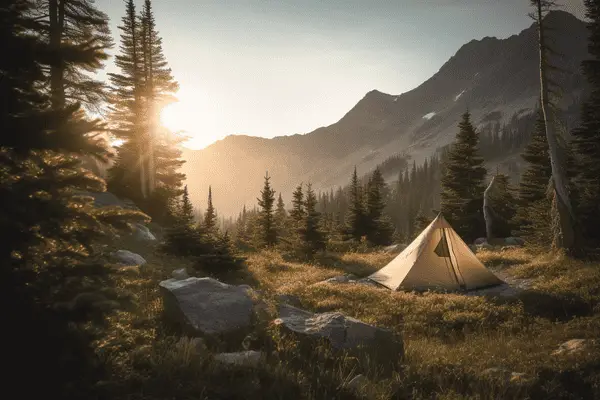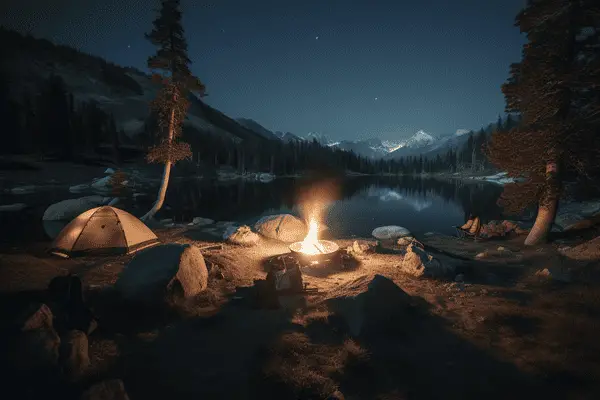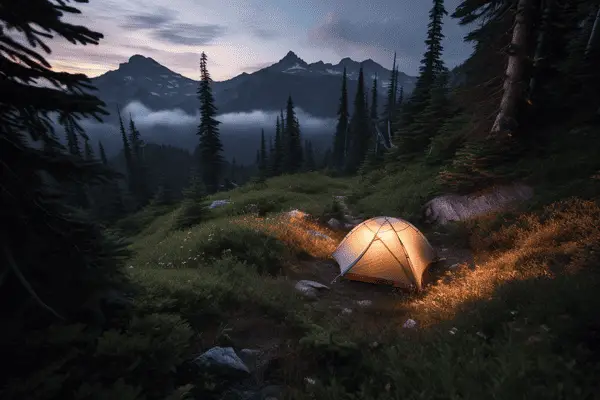We’ve all heard the terms dry camping vs boondocking thrown around but what do these terms mean and what is the difference between dry camping and boondocking?

Both dry camping and boondocking refer to camping in an RV, van, or tent without hookups or amenities. However, they differ slightly in terms of where the camping takes place.
Dry camping, also known as primitive camping, generally refers to camping in developed campgrounds without the availability of water, sewer, or electrical hookups. These campgrounds may still offer amenities such as pit toilets, picnic tables, and fire rings. Dry camping can also take place in designated areas within national parks, state parks, and national forests, where campers are expected to follow specific rules and guidelines.
Boondocking, on the other hand, usually refers to camping in remote, undeveloped areas on public lands, such as Bureau of Land Management (BLM) land or National Forests. This type of camping is often called “dispersed camping” or “wild camping” because it takes place outside of designated campgrounds. Boondocking typically involves finding your own campsite and may require a greater level of self-sufficiency, as there are no provided amenities.
Both dry camping and boondocking can be enjoyable experiences for those seeking a more rustic and off-the-grid experience. While both share similarities, they differ in the level of amenities and the specific locations where you can camp.
Delving into Dry Camping: Features and Locations
So, you’re curious about dry camping? It’s also called primitive or basic camping and is all about staying overnight in developed campgrounds or specific areas without water, sewer, or electrical hookups. But don’t worry, you won’t be totally roughing it. These campsites often have a few basic facilities like pit toilets, picnic tables, and fire rings to keep you comfortable.
You can find dry camping spots in national parks, state parks, and national forests. Just make sure you follow the rules and guidelines set by the folks who manage these areas. They might have rules about campfires, waste disposal, and noise levels, so everyone can have a good time while keeping the environment safe and clean.

One of the best things about dry camping is the chance to get away from the daily grind and really connect with nature. With fewer amenities, you can focus on the outdoors and enjoy a more laid-back camping experience. And let’s not forget the gorgeous scenery, diverse landscapes, and fun outdoor activities like hiking, wildlife watching, and stargazing! If you’re looking for a camping experience that offers peace and quiet with some basic facilities, dry camping might just be your perfect getaway.
Boondocking Basics: Remote Camping on Public Lands
Alright, let’s talk about boondocking! Sometimes called “dispersed camping” or “wild camping,” boondocking is all about venturing out and camping in remote, undeveloped areas on public lands. Think of it as taking your camping adventure up a notch – you’re going off the grid and finding your own campsite away from the crowds.
You can usually find boondocking spots on Bureau of Land Management (BLM) lands or in National Forests. Just remember, there won’t be any provided amenities, so you’ll need to be self-sufficient and well-prepared. Make sure you pack everything you need, like water, food, and camping gear, and have a plan for waste disposal. It’s all about leaving no trace and keeping our wild spaces clean and pristine for future generations.

Boondocking is perfect for those who crave solitude, adventure, and a real connection with nature. You’ll be surrounded by breathtaking landscapes, and without any nearby light pollution, the night sky will be absolutely incredible. Plus, it’s a great opportunity to sharpen your outdoor skills and learn how to be more self-reliant.
Just be sure to do some research before you go boondocking. Some areas may require a permit or have specific rules you need to follow. But once you’re out there, the sense of freedom and the thrill of exploration make boondocking an unforgettable experience for true nature lovers.
Key Differences Between Dry Camping and Boondocking
Dry camping and boondocking are similar but the experiences, locations, amenities, activities, and even the rules and regulations are different between each type of camping.
Here are the key differences between dry camping and boondocking at a glance.
| Aspect | Dry Camping | Boondocking |
|---|---|---|
| Location | Developed campgrounds or designated areas in national parks, state parks, and national forests. | Remote, undeveloped areas on public lands like BLM lands and National Forests. |
| Amenities | Basic facilities such as pit toilets, picnic tables, and fire rings may be available, but no water, sewer, or electrical hookups. | No provided amenities; campers must be self-sufficient. |
| Regulations | Specific rules and guidelines set by managing authorities, including restrictions on campfires, waste disposal, and noise levels. | Regulations may vary depending on the area; some locations may require permits, and campers must adhere to Leave No Trace principles. |
| Experience | Semi-rustic camping experience with access to basic facilities, offering a balance between comfort and connection to nature. | Rustic, off-grid camping experience focused on self-reliance, solitude, and a deep connection with nature. |
| Outdoor Activities | Access to various recreational activities such as hiking, wildlife watching, and stargazing. | Opportunities for exploration, adventure, and honing outdoor skills in remote settings. |
Essential Gear and Tips for Both Camping Styles
Whether you’re planning a dry camping trip or gearing up for some boondocking, there are some essential items and tips you’ll want to keep in mind. It’s all about staying safe, comfortable, and prepared for whatever Mother Nature throws your way.
First off, let’s talk about the essentials. You’ll need a reliable tent or RV, sleeping gear (like a sleeping bag and pad), and a good-quality backpack to carry your stuff. Don’t forget your cooking gear, too – a portable stove, utensils, pots and pans, and some non-perishable food will come in handy. And, of course, always pack enough water to stay hydrated and for cooking or cleaning purposes.
Since both dry camping and boondocking take you off the grid, it’s smart to have some basic navigation tools on hand. A map, compass, or GPS device can help you find your way and avoid getting lost in the great outdoors. A first aid kit is another must-have – accidents can happen, and it’s best to be prepared.
Now, let’s talk about some tips to make your camping experience even better. Always check the weather forecast before you head out and pack clothing and gear suitable for the conditions. Layering is key – it’s easier to add or remove layers as the temperature changes. And don’t forget a good pair of hiking boots or shoes for those long treks through nature.
Finally, make sure you practice Leave No Trace principles. This means packing out all your trash, minimizing your impact on the environment, and respecting wildlife and fellow campers. By doing this, you’re helping to preserve these beautiful natural spaces for generations to come.
Exploring Popular Destinations for Dry Camping and Boondocking
Are you ready to discover some amazing destinations for dry camping and boondocking? There’s a whole world of stunning landscapes, breathtaking views, and unforgettable experiences just waiting for you. Let’s dive into some popular spots you might want to add to your camping bucket list.
Places To Go Dry Camping
For dry camping enthusiasts, national and state parks across the US offer incredible opportunities. Some top picks include Yosemite National Park in California, with its towering granite cliffs and famous waterfalls; Zion National Park in Utah, known for its unique sandstone formations and scenic hikes; and Big Bend National Park in Texas, where you can explore the desert, mountains, and the Rio Grande. Each park has designated dry camping areas, so you’ll have a comfy base to explore all the natural wonders around you.
Places To Go Boondocking
Now, if boondocking is more your style, you’re in for a treat. The vast public lands managed by the Bureau of Land Management (BLM) and National Forests are a boondocker’s paradise. For instance, Quartzsite in Arizona is a popular winter destination for boondockers looking to escape the cold and enjoy the desert landscape. Another fantastic spot is Alabama Hills in California, which boasts unique rock formations and stunning views of the Sierra Nevada mountain range. And if you’re up for a real adventure, consider exploring the remote beauty of Alaska’s public lands, where you can truly get off the beaten path.
Remember, when choosing a destination for dry camping or boondocking, always do some research beforehand. Check for any regulations, permits, or restrictions in the area, and make sure you’re prepared for the specific conditions you’ll encounter. With a little planning, you’ll be all set to enjoy some of the most awe-inspiring destinations that dry camping and boondocking have to offer.
Conclusion: Choosing the Right Off-Grid Adventure for You
So, you’re ready to embark on an off-grid adventure, but how do you choose between dry camping and boondocking? The answer lies in your personal preferences, your camping experience, and the level of comfort and amenities you desire. Let’s break it down to help you make the best choice for your next camping trip.
If you’re looking for a more comfortable camping experience with some basic amenities like pit toilets and picnic tables, then dry camping might be the way to go. You’ll still get that awesome connection with nature, but with a little more convenience. Plus, dry camping in national and state parks gives you easy access to well-maintained trails, visitor centers, and other recreational activities.
On the other hand, if you’re craving solitude and a deeper connection with the wild, boondocking could be your perfect match. With no provided amenities, you’ll need to be more self-reliant and prepared, but the reward is a truly off-the-grid experience. Boondocking offers a sense of freedom and adventure that’s hard to beat, and it’s a great way to hone your outdoor skills.
Of course, there’s no rule that says you can’t try both styles of camping! Mixing it up can give you a well-rounded appreciation for the great outdoors and help you discover what works best for you. So, whether you choose to explore developed campgrounds or venture into remote public lands, the most important thing is to get out there, enjoy nature, and create lasting memories. Happy camping, and may your off-grid adventures be nothing short of amazing!
